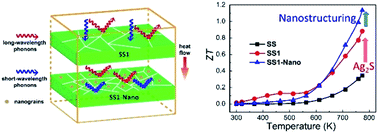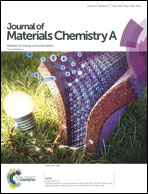Independently tuning the power factor and thermal conductivity of SnSe via Ag2S addition and nanostructuring†
Abstract
Single-crystal SnSe has been reported to exhibit ultralow thermal conductivity and high thermoelectric performance. For future large-scale thermoelectric applications, however, polycrystalline SnSe would offer more advantages. Unfortunately, its thermoelectric figure of merit (ZT) is much poorer than that of single crystal. Improvements are challenging because the reduction in thermal conductivity is usually accompanied by a degradation in the power factor. Here we report how the thermal conductivity of polycrystalline SnSe can be reduced by Ag2S addition and nanostructuring while avoiding this downside. We investigated the thermoelectric properties of Ag2S-added SnSe polycrystals in the range from 300 to 773 K. We obtained a peak ZT of 0.88 in SnSe with 1% Ag2S addition (SS1), twice as high as pristine SnSe (SS). The thermal conductivity is depressed even further in a nanostructured SnSe + 0.01Ag2S sample (SS1-Nano). More importantly, at high temperature the power factor remains as high as that of the SS1 sample. Due to a minimum thermal conductivity of 0.30 W m−1 K−1, we obtained a maximum ZT of 1.13 in the SS1-Nano sample at 773 K.



 Please wait while we load your content...
Please wait while we load your content...